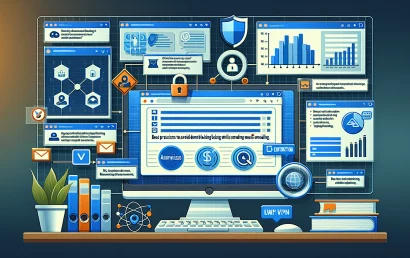"New Domain Warm-Up: A Step-by-Step Guide"

When venturing into the world of email marketing, one of the most crucial steps is to properly warm up your new domain. Domain warming is the process of gradually increasing your email sending volume to establish a positive reputation with email service providers (ESPs). This is essential for ensuring that your emails land in the inbox rather than the dreaded spam folder.
In this comprehensive guide, we will walk you through a step-by-step process to effectively warm up your new domain. By following these steps, you can enhance your email deliverability and ensure that your marketing campaigns reach your audience successfully.
Understanding the Importance of Domain Warming
Before diving into the steps of warming up your domain, it’s essential to understand why this process is necessary. Email service providers use various algorithms to determine the legitimacy of an email sender. If your new domain sends a large volume of emails right from the start, it may raise red flags, leading to poor deliverability rates.
“A well-warmed domain is like a trusted friend in the world of email marketing; it opens doors to successful communication.”
Step 1: Set Up Your Domain Correctly
Before you begin the warming process, ensure that your domain is set up correctly. This includes:
- Configuring DNS Records: Set up SPF, DKIM, and DMARC records to authenticate your emails.
- Creating a Professional Email Address: Use a recognizable email address that reflects your brand.
Step 2: Start with a Low Volume
Begin your warming process by sending a small number of emails. Start with around 10-20 emails per day for the first week. Gradually increase the volume each week. This slow increase helps to build your domain's reputation without triggering spam filters.
Step 3: Focus on Engagement
During the warming phase, it’s crucial to focus on sending emails to engaged users. Target your existing contacts who are likely to open and interact with your emails. This not only helps in building a positive sender reputation but also improves your overall engagement rates.
By following these initial steps, you can lay a solid foundation for your domain warming journey, ensuring that your future email marketing efforts are successful.
Main advantages and disadvantages
Advantages of Domain Warming
Warming up your new domain comes with several benefits that can significantly impact your email marketing success:
- Improved Deliverability: A properly warmed domain is less likely to be flagged as spam, ensuring that your emails reach the inbox of your recipients.
- Enhanced Sender Reputation: Gradually increasing your sending volume helps establish a positive reputation with email service providers, which is crucial for long-term success.
- Better Engagement Rates: By targeting engaged users during the warming process, you can improve your overall open and click-through rates, leading to more effective campaigns.
- Reduced Risk of Blacklisting: A slow and steady approach minimizes the risk of your domain being blacklisted, protecting your brand’s credibility.
Disadvantages of Domain Warming
While the advantages are significant, there are also some drawbacks to consider when warming up a new domain:
- Time-Consuming: The warming process requires patience, as it can take several weeks to see the desired results.
- Requires Strategy: A successful warming strategy needs careful planning and execution, which can be challenging for those new to email marketing.
- Limited Immediate Impact: Initially, you may not see immediate results in terms of engagement and conversions, which can be discouraging.
- Potential for Mistakes: If not executed properly, you risk damaging your domain's reputation instead of building it, leading to long-term consequences.
Thematic table
| Step | Description | Actions | Expected Outcome |
|---|---|---|---|
| 1 | Set Up Your Domain Correctly |
| Foundation for successful email delivery |
| 2 | Start with a Low Volume |
| Builds sender reputation without triggering spam filters |
| 3 | Focus on Engagement |
| Improves overall engagement and sender reputation |
| 4 | Monitor Deliverability |
| Identifies potential issues early |
| 5 | Gradually Increase Volume |
| Strengthens sender reputation over time |
| 6 | Evaluate and Adjust |
| Optimizes future email campaigns |
| 7 | Establish Consistency |
| Builds long-term trust with email service providers |
Let's summarize the category:
Warming up a new domain is a critical process for anyone looking to succeed in email marketing. By following a structured approach, you can enhance your email deliverability and establish a strong sender reputation. Each step in the warming process serves a specific purpose, from setting up your domain correctly to gradually increasing your sending volume.
“A well-executed domain warming strategy can be the difference between your emails landing in the inbox or being lost in the spam folder.”
Throughout this guide, we have highlighted the importance of starting with a low volume, focusing on engagement, and consistently monitoring your deliverability metrics. These practices not only help you build a reputable domain but also foster trust with email service providers.
Moreover, understanding the advantages and disadvantages of domain warming allows you to approach the process with realistic expectations. While it may take time and effort, the long-term benefits of improved engagement rates and reduced risk of blacklisting are invaluable.
Ultimately, a successful domain warming strategy lays the groundwork for effective email marketing campaigns that can drive results and grow your business. Embrace the process, stay committed, and watch your email marketing efforts flourish.





